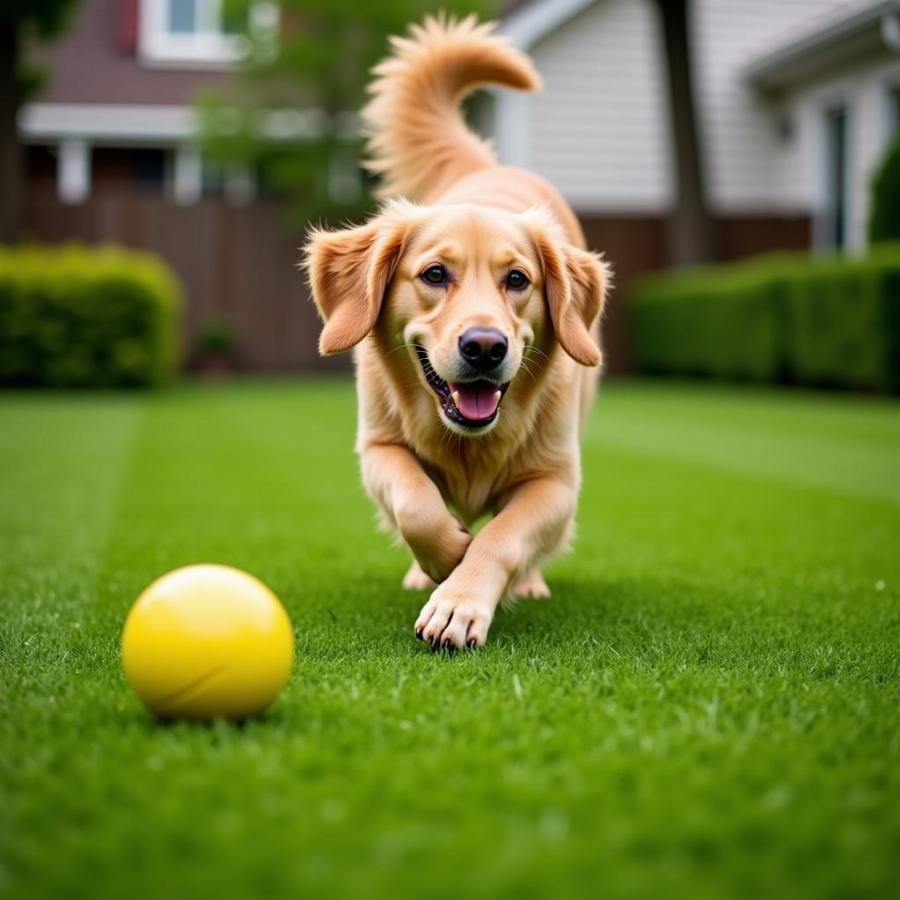Artificial lawn is becoming increasingly popular with dog owners, offering a low-maintenance, mud-free alternative to natural grass. But is it right for your furry friend? This guide explores everything you need to know about artificial lawn for dogs, from choosing the right type to maintenance and potential concerns. We’ll cover the pros and cons, help you select the perfect turf, and provide expert advice on keeping it clean and safe for your canine companion.
Is Artificial Grass Safe for Dogs?
Yes, generally speaking, modern artificial grass is safe for dogs. However, it’s crucial to choose a high-quality product specifically designed for pets. Look for non-toxic materials and avoid options with harmful chemicals. Also, consider the infill material used, as some types can retain heat, which can be uncomfortable for dogs, especially in hot climates. Opt for cooling infill options or consider installing the turf in a shaded area.
Choosing the Right Artificial Lawn for Your Dog
Selecting the right artificial turf involves several factors. Durability is key, as dogs can be tough on surfaces with their running and playing. Look for tear-resistant and robust options designed to withstand heavy use. Drainage is another important consideration, as you want to avoid puddles and ensure efficient waste removal. Finally, consider the pile height and texture. A shorter pile is generally better for dogs, as it’s easier to clean and less likely to trap debris.
 Dog playing fetch on artificial grass
Dog playing fetch on artificial grass
Maintaining Your Artificial Lawn for Dogs
Maintaining artificial grass for dogs is relatively simple. Regular rinsing with water will help remove urine and other waste. For solid waste, scoop it up as you would on natural grass and then rinse the area. You can also use a pet-safe disinfectant occasionally to neutralize odors and bacteria. Brushing the turf periodically will help prevent matting and keep it looking its best.
Pros and Cons of Artificial Grass for Dogs
Like anything, artificial turf for dogs has its advantages and disadvantages. On the plus side, it’s low maintenance, eliminates muddy paws, and provides a consistent, even surface for play. It can also be beneficial for dogs with allergies. On the downside, it can get hot in direct sunlight, and some dogs may initially be hesitant to use it. Understanding these pros and cons can help you make an informed decision.
Common Concerns about Artificial Turf and Dogs
Many dog owners worry about the heat, cleaning, and potential toxicity of artificial grass. While these are valid concerns, they can be addressed by choosing the right product and implementing proper maintenance practices. Look for best artificial turf for dogs with cooling infill, use pet-safe cleaners, and ensure the materials used are non-toxic.
What is the Best Infill for Artificial Grass for Dogs?
The best infill options for dogs are those that offer good drainage and cooling properties. Infill materials like Zeolite and Envirofill are popular choices, as they help reduce heat buildup and control odors. Avoid crumb rubber infill, as it can retain heat and may contain harmful chemicals. You can explore more options for grass replacement for dogs on our website.
Will Dog Urine Stain Artificial Grass?
While artificial grass is designed to be stain-resistant, dog urine can sometimes cause discoloration or odor, especially if not cleaned regularly. Rinsing the area with water after your dog urinates is usually sufficient. If you notice discoloration, you might be interested in our article on dog urine green color. Consistent cleaning will help maintain the appearance and hygiene of your artificial lawn.
Conclusion
Artificial lawn can be a fantastic option for dog owners seeking a low-maintenance and aesthetically pleasing alternative to natural grass. By carefully considering the factors outlined in this guide and selecting a high-quality product, you can create a safe, comfortable, and enjoyable outdoor space for both you and your furry companion.
FAQ
-
How often should I clean artificial grass for dogs? Rinsing after each urination and scooping solid waste daily is recommended. Deeper cleaning can be done weekly or monthly.
-
Can I use any cleaner on artificial turf for dogs? No, use only pet-safe cleaners specifically designed for artificial grass.
-
Is artificial grass suitable for all dog breeds? Yes, but consider your dog’s individual needs, such as sensitivity to heat.
-
Does artificial grass require any special installation? Professional installation is recommended for optimal drainage and durability.
-
Is artificial grass more expensive than natural grass? The initial cost is higher, but long-term maintenance costs are typically lower.
-
Can I put dog waste bags in my regular trash after picking up from artificial grass? Yes, dispose of dog waste as you normally would.
-
Will my dog like artificial grass? Most dogs adapt quickly, but some may need time to adjust.
Further Reading
For more information, check out our articles on dog poop yellow and dog foot wax.
About Beaut Dogs
Beaut Dogs is your go-to resource for all things related to dog care, offering expert advice on breeds, health, nutrition, and training. We provide comprehensive guides and helpful tips to ensure your canine companion thrives. For personalized assistance, please reach out to us via Email at [email protected]. We’re here to help you navigate the wonderful world of dog ownership. We at Beaut Dogs are committed to providing accurate and valuable information for dog lovers.